|
Netherlands East Indies
1925
Railway Company stamp.
Designer:
print:
paper:
Glue:
Watermark: no
Value:
Perforation:
Not in official catalogue
|
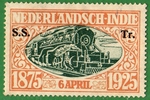
|
1933 - 1937
Queen Wilhelmina. The stamps show a goods waggon on the dockside and a railway viaduct.
 
Designer: Ir. A. Kreisler
print: Johan Enschedé
paper: photogravure
Glue: ?
Watermark: no, except: NVPH 253-265: horizontal rings
Values: 10, 12½, 15, 20, 25, 30, 32½, 35, 40, 42½, 50, 60, 80 cents, 1, 1,70 , 2, 2,50 , 5 guilders
Perforation: L12½
Valid till: 30 - 6 - 1941 (12½, 32½, 42½ cents, 1,75 , 2,50 , guilders) / 31 - 12 - 1945 (rest)
Catalogue numbers:
Stanley Gibbons 334 - 345 - 348 - 349 - 350 - 352 - 353 - 354 - 355 - 356 - 357 - 358 - 359 - 403 - 404 - 405 - 408 - 414 - 415 /
Michel 193 - 214 - 215 - 216 - 217 - 218 - 219 - 220 - 221 - 222 - 223 - 224 - 225 - 226 - 227 - 228 /
Yvert Tellier ? - 169 - 188 - 189 - 190 - 191 - 192 - 193 - 194 - 195 - 196 - 197 - 198 - 199 - 200 - 201 /
NVPH 181 -195 - 196 - 197 - 198 - 199 - 200 - 201 - 202 - 203 - 204 - 205 - 206 - 207 - 208 - 209 -210 - 253 - 254 - 255 - 256 - 257 - 258 - 259 - 260 - 261 - 262 - 263 - 264 - 265
|
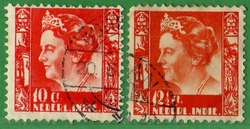
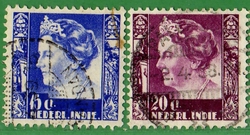
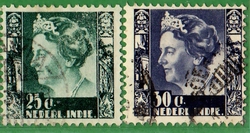
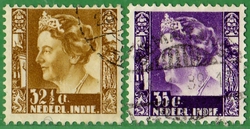
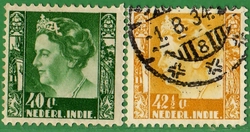
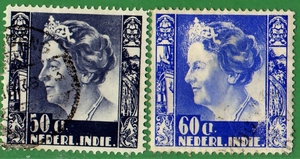
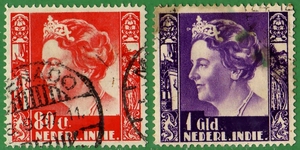
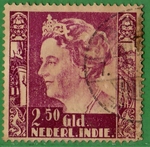

|
2-12-1940
Queen Wilhelmina overprinted Red Cross.
Designer: Ir. A. Kreisler
print: Johan Enschedé
paper: photogravure
Glue: ?
Watermark: no
Values: 10 + 5 cents
Perforation: L12½
Valid till: 30 - 6 - 1941
Circulation: 500,000
Catalogue numbers: Stanley Gibbons 428 / Michel 287 / Yvert Tellier 284 / NVPH 273
|
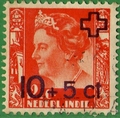

|
1946
Railway bridge at Sukabumi.
The strategic location of the city of Sukabumi between Batavia and Bandung and the crops that the soil yielded to the Dutch East Indies government have contributed a lot to the construction of the railway line from Buitenzorg (Bogor) to the city of Sukabumi. The railway was built in 1882 by the Nederlandsch-Indische Spoorweg Maatschappij (N.I.S.) and became the distribution artery in the transport of products such as tea, coffee and quinine to the port of Tandjong Priok in Batavia.
Designer: Jan Staal
print: Nederlandsch Indische Gouvernementsdrukkerij, Melbourne
paper: offset
Glue: ?
Watermark: crown
Values: 1 cent
Perforation: K14½ : 14
Valid till: 31 - 12 - 1949
Catalogue numbers: Stanley Gibbons 484 / Michel 333 / Yvert Tellier 298 / NVPH 317
|


|
1947
Railway bridge at Sukabumi overprinted.
Designer: Jan Staal
print: Nederlandsch Indische Gouvernementsdrukkerij, Melbourne
paper: offset
Glue: ?
Watermark: crown
Values: 4 cents on 1 cent
Perforation: K14½ : 14
Valid till: 31 - 12 - 1949
Catalogue numbers: Stanley Gibbons 504 / Michel 340 / Yvert Tellier 305 / NVPH 324
|


|
1947
Queen Wilhelmina overprinted.
Designer: Ir. A. Kreisler
print: Johan Enschedé
paper: photogravure
Glue: ?
Watermark: no
Values: 45 cents on 60 cents
Perforation: K14½ : 14
Valid till: 31 - 12 - 1949
Circulation: 495,850
Catalogue numbers: Stanley Gibbons 505 / Michel 341 / Yvert Tellier 310 / NVPH 325
|


|
1947
Queen Wilhelmina overprinted.
Designer: Ir. A. Kreisler
print: Johan Enschedé
paper: photogravure
Glue: ?
Watermark: no
Values: 12½, 25, 50, 80 cents
Perforation: K14½ : 14
Valid till: 31 - 12 - 1949
Circulation: NVPH 326: 2,975,600; 327: 589,800; 329: 388,900; 330: 284,750
Catalogue numbers: Stanley Gibbons 506 - 507 - 509 - 510 / Michel 342 - 343 - 345 - 346 / Yvert Tellier / NVPH 326 - 327 - 329 - 330
|
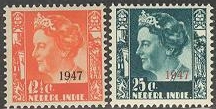
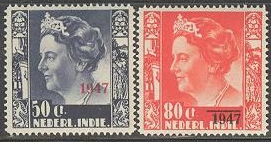

|
1948
Queen Wilhelmina overprinted.
Designer: Ir. A. Kreisler
print: Johan Enschedé
paper: photogravure
Glue: ?
Watermark: no
Values: 15 on 10 cents
Perforation: K14½ : 14
Valid till: 31 - 11 - 1948
Circulation: 495,252
Catalogue numbers: Stanley Gibbons 513 / Michel 349 / Yvert Tellier 314 / NVPH 333
|
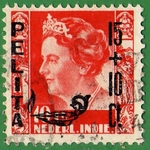

|
5 - 12 - 1955
Petroleum Refinery in Aruba with railway lines.
Designer: E. Bartels
print: offset, Johan Enschedé
paper:
Glue:
Watermark: no
Value: 25 cents
Perforation: L 12¼
Catalogue numbers: Stanley Gibbons 353 / Michel 51 / Yvert Tellier 244 / NVPH 256
|
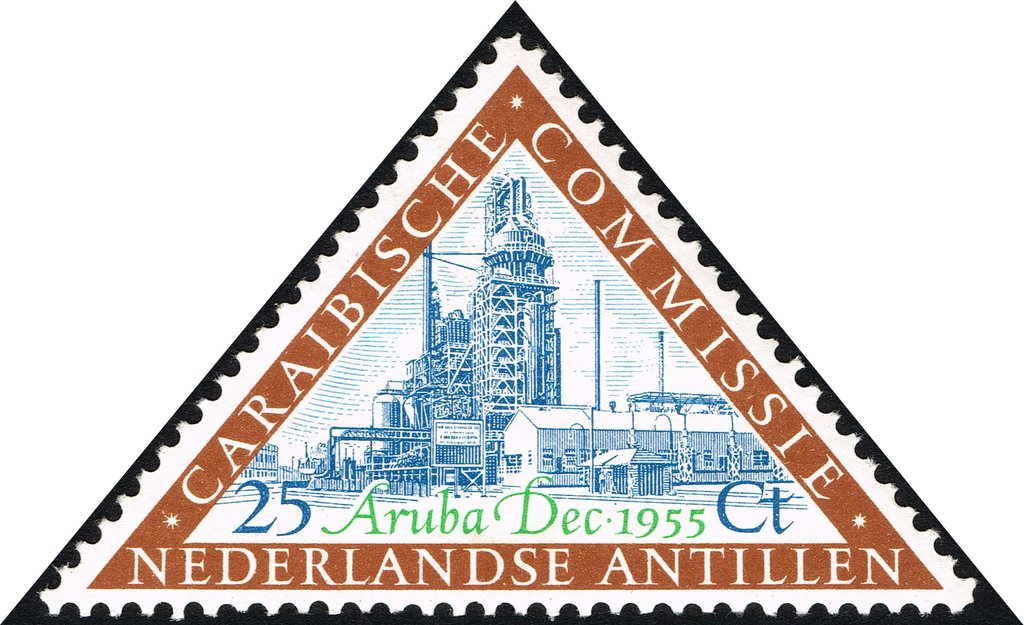

|
26 - 6 - 1992
Willemstad harbour, container port with railway track. Below the stamps there are two maximum cards with the subject.
Designer: Humphrey C. Elisabeth
print: offset, Johan Enschedé
paper:
Glue:
Watermark: no
Value: 80 and 125 cents
Perforation: K14 : 12¾
Catalogue numbers: Stanley Gibbons / Michel 752-753 / Yvert Tellier 929-930 / NVPH 1006-1007
|

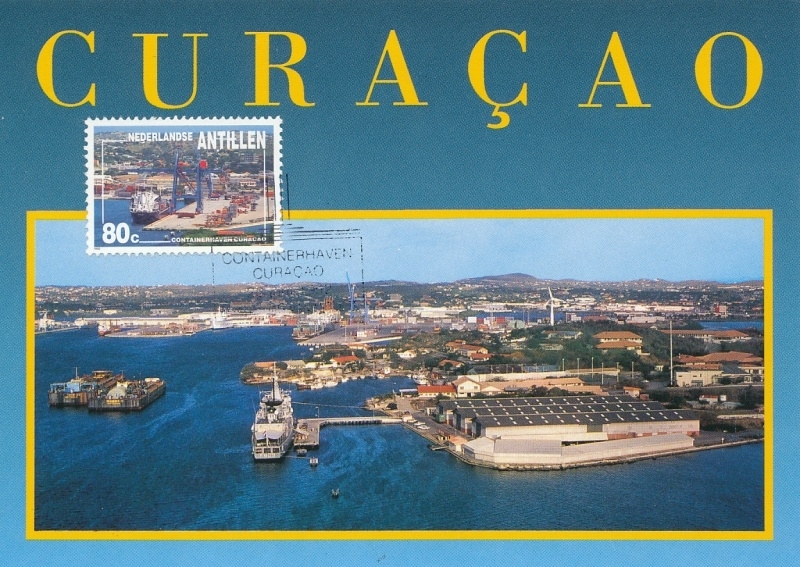
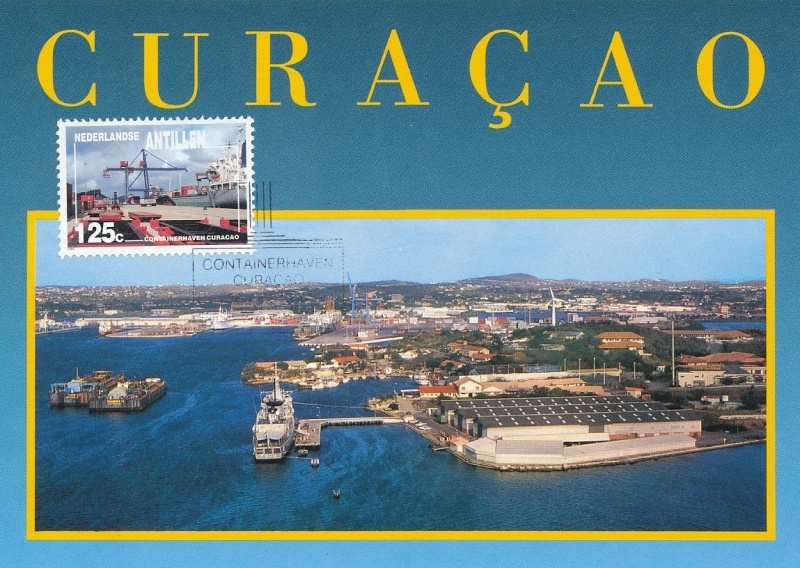

|
27 - 4 - 2004
Diesel locomotive 1977.
First stamp of a series of 6 stamps.
Designer: Robert A. Willems
print: offset, Johan Enschedé
paper: non-phosphorescent
Glue: ?
Watermark: no
Value: 10 cents
Perforation: K13¼ : 12¾
Catalogue numbers: Stanley Gibbons / Michel 1286 / Yvert Tellier 1437 / NVPH 1507
|
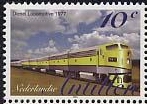

|
|
Surinam
Dutch colony till 1975.
|
November 1945.
From a set of 9:
Goods waggon at bauxite mine in Mungo;
Mine truck at a gold mine;
Steam sugar-cane train.
Mungo was founded in the early 20th century, after the Surinaamsche Bauxiet Maatschappij (SBM) discovered recoverable reserves of bauxite in the area in 1916. The SBM, later renamed Suriname Aluminum Company (Suralco), was a wholly owned subsidiary of the Aluminum Company of America (Alcoa). Initially, Mungo was only accessible via the river. The Cotticariver was made navigable for sea-going vessels that came to Mungo to collect the bauxite. In 1922, the first bauxite was exported to Trinidad to be shipped from there to the United States. Mungo had a harbour with a basin, where the ships could turn.
Gold mining companies were still active at Benzdorp in the 1950s. These activities were also discontinued due to the persistently low gold price. A second gold rush occurred after 1970 as a result of the rapid rise in the gold price. The government introduced a mining method using sand dredgers operating from pontoons (skalians) on the river. The Internal War disrupted these activities from 1986. Gold mining was then largely controlled by the Jungle Command, which had an important source of income from it. After the war, small-scale extraction remained active in the 1990s, partly due to the difficult economic situation. In the twenty-first century, a larger-scale gold industry also emerged, so that the second gold rush in 2020 is still ongoing.
For two hundred years, sugar cane was the most important agricultural crop in Suriname. In the mid-1970s, Mariënburg plantation remained with an area of 2300 hectares, until it also stopped its activities in 1986.
Designer:-
print: American Bank Note Co, New York
paper:
Glue: ?
Watermark: no
Value: 1 cent, 5 cents, 7½ cents
Perforation: L 12
Catalogue numbers: Stanley Gibbons 313 - 319 - 321 / Michel 241 - 247 - 249 / Yvert Tellier 207 - 213 - 215 / NVPH 220 - 226 - 228
|

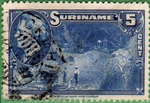
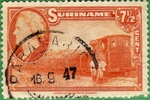

|
23 - 7 - 1945.
Steam sugar-cane train overprinted.
Designer:-
print: American Bank Note Co, New York
paper:
Glue: ?
Watermark: no
Value: 7½ cents + 5 cents
Perforation: L 12
Catalogue numbers: Stanley Gibbons 307 / Michel 268 / Yvert Tellier / NVPH 214
|
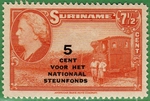

|
9 - 8 - 1950
Steam sugar-cane train overprinted.
And the last day cover for this stamp: 31-12-1962.
Designer:-
print: American Bank Note Co, New York
paper:
Glue: ?
Watermark: no
Value: 7½ cents + 1 cent
Perforation: L 12
Catalogue numbers: Stanley Gibbons 383 / Michel 319 / Yvert Tellier / NVPH 284
|
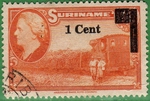
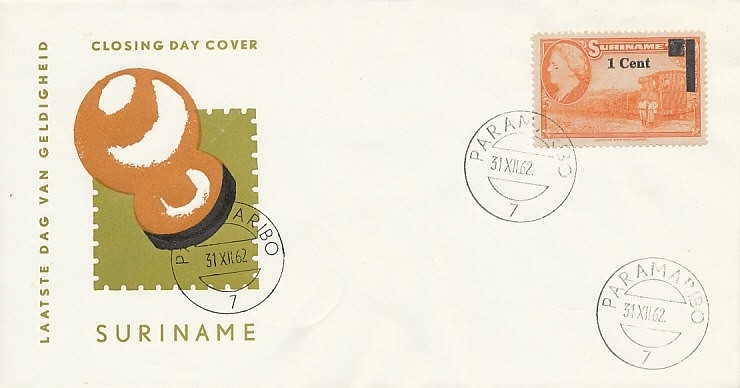

|
9 - 10 - 1965
Diesel locomotive and side-dump trucks at the Mungo bauxite mine.
First of a set of 4.
The first day cover is also shown here.
Design: after photographs by Suralco (Surinam Aluminium Company)
print: Johan Enschedé
paper: photogravure
Glue: ?
Watermark: no
Value: 10 cents
Perforation: K 13¼ : 12½
Circulation: 273,632
Catalogue numbers: Stanley Gibbons 563 / Michel 474 / Yvert Tellier 412 / NVPH 427
|

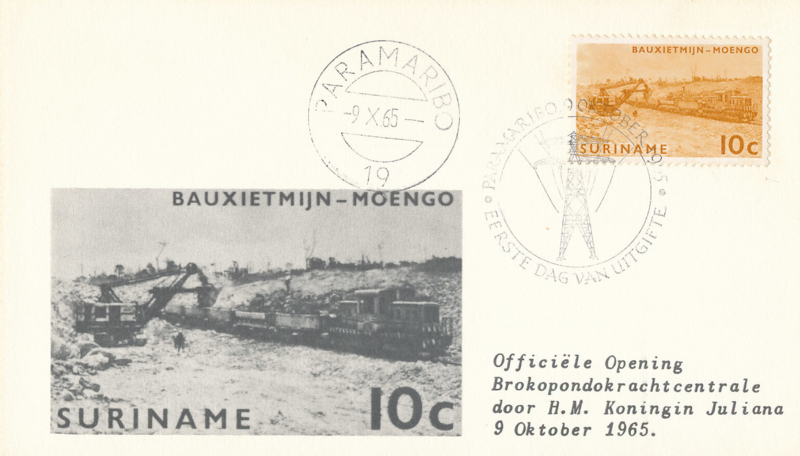

|
13-11-2015
From a series of six stamps with Aruban Touristic Spots: a local tram.
The Oranjestad tramline is a single-track tram line in the capital city of Aruba.
The line is the first and so far the only passenger rail service on the island and the rest of the Dutch Caribbean, and the second of any kind, after an industrial branch that was closed in 1960. It was inaugurated on 22 December 2012, seven days after the arrival of the first single-deck car. Regular service started on 19 February 2013.
The second car, an open-top double-decker, was delivered in June 2013.
The heritage style streetcars were designed and manufactured by TIG/m Modern Street Railways in California, USA.
The line operates daily.
The line starts from a balloon loop near the Port of Call and serves the downtown area with a route along Schelpstraat, Havenstraat and Caya Betico Croes, the main road, which is open to pedestrians only. Between Rancho and Plaza Chipi Chipi, eastbound trams (towards Plaza Nicky) run via Schelpstraat, and westbound ones (towards Port of Call), run via Havenstraat. It ends at Plaza Nicky, with a stop also located on a loop.
There are a total of 9 stops situated approximately 200 metres (660 ft) apart from each other. The depot is located between the stops at Port of Call and Rancho.
Design:
print: Joh. Enschedé.
paper: offset
Glue: ?
Watermark: no
Value: 250 cents
Perforation: K 14 : 12¾
Circulation: -
Catalogue numbers: Stanley Gibbons 868 / Michel 913 / Yvert Tellier 887 / NVPH 852
|


|
30-11-2018
From a series of five stamps about sustainable energy: a local tram.
The Oranjestad Streetcar (Dutch: Tram van Oranjestad) is a single-track tram line in Oranjestad, the capital city of Aruba.
It is owned and operated by Arubus, the national public transportation company. It was built as a key component of a larger project to upgrade
the main retail areas of the town.
The fleet is composed of 4 streetcars: 2 single-decker (green and orange) and 2 open-top double-decker (blue and red) cars.
The vehicles, assembled by TIG/m in Chatsworth, USA, use hydrail technology: they are powered by batteries augmented by hydrogen fuel cells.
Design:
print: Joh. Enschedé.
paper: offset
Glue: ?
Watermark: no
Value: 220 cents
Perforation: K 14 : 12¾
Circulation: -
Catalogue numbers: Stanley Gibbons / Michel 1065 / Yvert Tellier 1045 / NVPH 1014
|
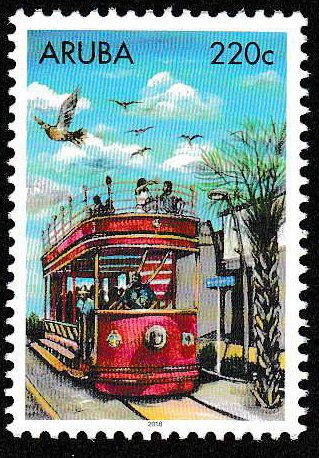

|
30-11-2020
The Aruba phosphate Company.
Phosphate was extracted in Aruba at Seroe Colorado and Seroe Culebra from 1880 to 1895. The Aruba Phosphaat Maatschappij employed about 300 people.
Phosphoric acid is mainly used in fertilizer production, in detergents, anti-rust agents and in small quantities in soft drinks such as cola.
Phosphates were discovered at Seroe Colorado and Seroe Colebra around 1873. In 1879 the "Aruba Phosphaat Maatschappij" (APM) was founded. Machinery, locomotives, rails and other supplies were imported. From the activity on the island especially the port of San Nicolas benefited. The port developed into a modern port.
The phosphate appeared on the surface in layers up to a depth of almost six meters. Later, phosphate was also found at greater depths. Between the mines and the bay of San Nicolas there was a narrow railway on which a small locomotive pulled long rows of cars with phosphate. In the early 1880s, the first cargo of Aruban phosphate was shipped to England.
Later, the price of phosphate on the world market fell because phosphate was mined in several other countries as well. In 1894 production was already a lot less and the company could not continue. The mines were closed in 1895.
In total, the Aruba Phosphaat Maatschappij exported more than 446,445 tons of phosphate.
Design: Rogelio Montero
print: Joh. Enschedé.
paper: offset
Glue: ?
Watermark: no
Value: 90, 130, 220 and 320 cents
Perforation:
Circulation: -
Catalogue numbers: Stanley Gibbons / Michel / Yvert Tellier / NVPH
|
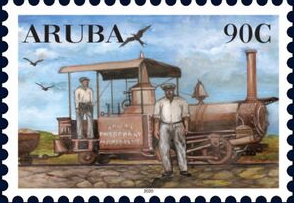

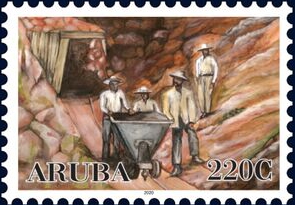
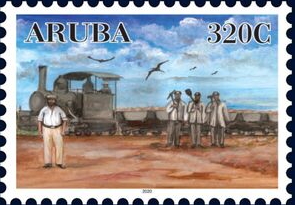

|
|
Curaçao
Dutch colony till 2010, when it became an independent country within the Kingdom of the Netherlands.
|
12-04-2012: History of Railway transportation in Curaçao
This sheet issued by the island's Nieuwe Post N.V.(=Ltd.) shows the history of rail travel in the island of Curaçao.
The 200c stamp shows dumping cars at Tafelberg, where a phosphate Mine was exploited by John Godden who leased Tafelberg mountain from
plantation owner Cornelis Gorsira. Godden also built a wharf at Fuikbay near the Mine. To haul the mineral from the mine to the wharf
an inclined-plane, double track railway was built where donkeys used to haul the dumping cars. In 1887 Godden shut the mine after
a dispute over concession taxes with the government. In 1910 the mine was reopened by a new company: The Curaçao Mining Co.
The 300c stamp shows a gasoline powered Plymouth 4-tonner loco manufactured in Ohio, which was purchased by the company in the 1930s.
It is one of the early series of locos of the Curaçao Michelning Company.
The 250c stamp shows the horse-drawn tram in Punda. In the 19th century Curaçao became a major trading centre where ships moored at Schottegat
harbour to buy coal. In the 1880s there was need for a transportation system to get people from their homes to wharfs and businesses, since
Waaigat bay separated the districts Punda, Otrabanda en Scharloo from each other. Two bridges, Queen Emma Bridge across St. Anna Bay and
Van den Brandhof bridge across Waaigat Bay, and a few ferries shortened travelling times. A horse-drawn tram, a light two-axle vehicle with
two bench seats and boarding steps for standing passengers, offered an hourly service along a one kilometre route: the tram set out from
Queen Emma Bridge, ran along Breedestraat in Otrabanda and then arrived at the Roman Catholic Cemetery.
The 350c stamp shows the motor tram at Otrabanda, which was introduced in Curaçao in 1910. The Curaçao Tramway Service was operated by
Mr de Sola and Mr Cardoze. The 30 gallon gasoline powered tram was made in Great Britain. The seven transverse seat could accommodate 35 passengers
and a few more could stand on the steps. It ran at a maximum speed of 15 kilometres per hour. The gasoline can was located under one of the car seats
and the muffer was on the roof of the tram. In 1920 the line was closed and taken over by a bus service, due wear because of hard usage and
lack of spare parts.
So in 1920 35 years of railway transport in Curaçao was over.
Furthermore you see the FDC for a stamp sheet issued by the island's Nieuwe Post N.V.(=Ltd.) showing the history of rail travel in the island of Curaçao. Issued 12 April 2012.
Design: Richmond Gijsbertha
print: Johan Enschedé Stamps Security Printers, Haarlem, The Netherlands
paper: offset coated stamp paper
Glue: synthetic
Watermark: no
Value: 200 + 250 + 300 + 350 cents = 11 Curaçao Guilders
Perforation: 13¾ : 14
Size of stamps: 30 x 40 mm / 40 x 20 mm
Size of souvenir sheet: 110 x 110 mm
Circulation: -
Catalogue numbers: sheet: Stanley Gibbons 1205 / Michel 6 / Yvert Tellier 5 / NVPH 77
Catalogue numbers: stamps: Stanley Gibbons 1205a-1205d / Michel 92-95 / Yvert Tellier 5a-5d / NVPH 77a-77d
|

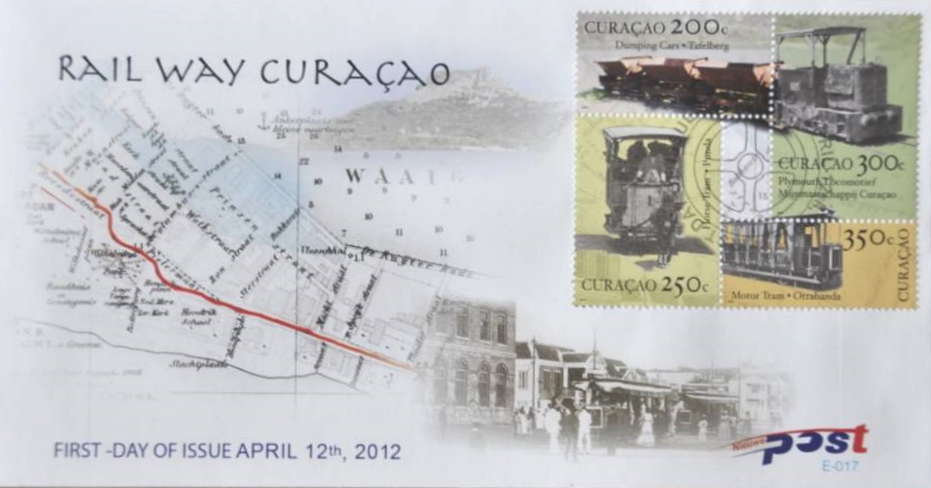

|
21-06-201: South American Railways
Stamp sheet with locomotives from:
Colombia: Freight train in Aracataca, Colombia;
Ecuador: In the village of Alausi. Typical houses as well as the famous old wooden train on the railway station;
Argentina: Cargo train crossing Argentinian Patagonia;
Bolivia: Charge Train in Avaroa, Bolivia;
Brazil: Green freight train passing by old railway station in a city in the interior of the State of São Paulo;
Peru: Train on a railroad track with a mountain range in the background, Puno.
The photo of the railroad track in the South American wide landscape has been made black and white at the bottom and in color at the top. This gives the stamp sheet an industrial character and in the stamps this color variant of the background photo can be used. This gives the complete souvenir sheet a transparent effect and adds depth to it.
Design:
print:
paper: offset
Glue:
Watermark:
Values: 70c + 1 + 2 + 334c + 478c + 746c (c= Netherlands Antillian cents)
Perforation:
Size of stamps: 30 x 30 mm
Size of souvenir sheet:
Circulation: -
Catalogue numbers: stamps: Stanley Gibbons / Michel / Yvert Tellier / NVPH 7
|
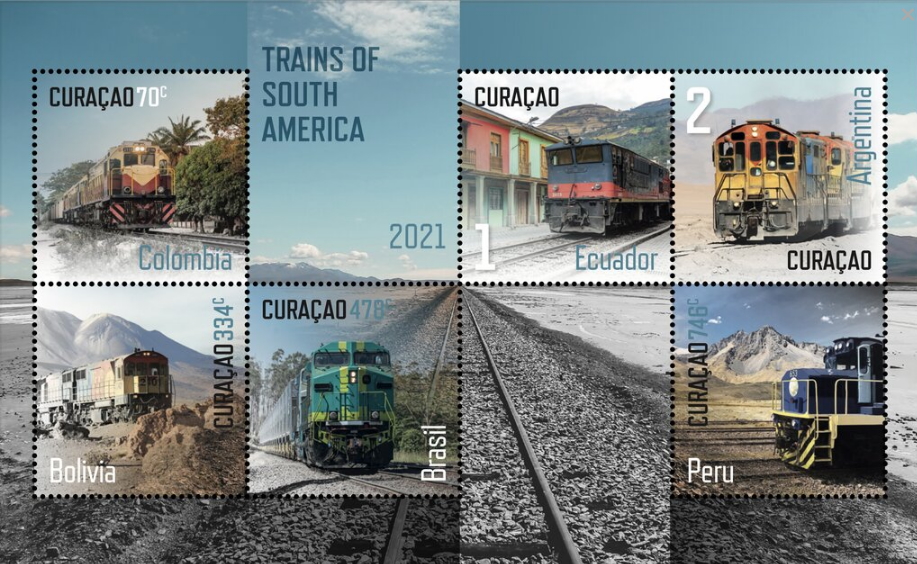

|
|
St. Maarten
Formerly part of the Netherlands Antilles till 2010, when it became an independent country within the Kingdom of the Netherlands.
|
No stamps with railway related subjects yet.
|

|
|
Carribean Netherlands (Saba, St. Eustatius, Bonaire)
Formerly part of the Netherlands Antilles, and Dutch municipalities since 2010.
|
2021: Sint-Eustatius
European Year of Rail. Eight personalised stamps with trains.
Catalogue numbers: stamps: Stanley Gibbons / Michel / Yvert Tellier / NVPH
|
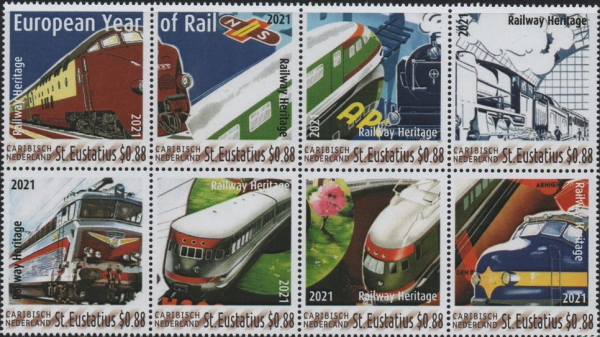

|